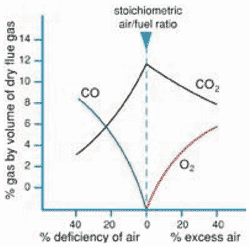Combustion Booklet
- Author:
- Michael Biarnes
- Collaborators:
- Jason Esteves
- Bill Freed
- Download PDF:
- Combustion Booklet 2006 (PDF, 856Kb)
Table of Contents
- Combustion
- Efficiency
- Emissions
- Analysis
- Summary
What is Combustion Analysis?
During combustion analysis, the quantities and concentrations of gases are measured precisely in order to maintain the safest and most efficient conditions possible. The first step in combustion analysis is the measurement of gas temperature, flue gas concentrations, as well as draft pressures and soot levels. These measurements are made by inserting a probe into the exhaust flue and taking a sample. A carefully positioned thermocouple measures the highest exhaust gas temperature. The draft pressure is calculated by finding the difference in pressure between the inside and the outside of the exhaust flue. The concentrations of the undesired combustion gases can be measured using different kinds of methods such as the electrochemical and non-dispersive infrared sensors.
Mass Emissions and Gas Velocityreturn
Mass emissions are a calculation of the total amounts of gases being released during the combustion process. Instead of finding concentrations of gases in ppm (parts per million volume), mass emissions indicate the total amount of emissions being released in units such as LB/H (pounds per hour) or tons per year. Mass emissions can be found by knowing the concentration of the gases being released, the amount of fuel that is burned, and the mass of the fuel. To know the mass of the fuel however, it is necessary to know the exact chemical formula for the fuel. Another way to calculate mass emissions is based on the velocity of the gases being sent out of the stack, the cross sectional area of the stack, and the concentration of the gases being sent out of the stack.
O2 and CO2 Depending on Excess Airreturn


Gas Analyzersreturn
Gas Analyzers are the ideal tool to monitor gas emissions and therefore maintain the best Total Efficiency, which, as we discussed, is a balance between the combustion efficiency, environmental efficiency, and a safe working environment. In addition, Combustion Analyzers/Gas Analyzers can help identify maintenance problems as the boilers deteriorate with time.
Many gas analyzers measure and calculate a wide array of parameters including:
- Combustion Efficiency
- O2
- CO2
- Flue Gas Temperature
- Ambient Temperature
- Draft
- CO
- Excess Air
- True NOx (NO + NO2)
- SO2
- H2S
- Hydrocarbons (CxHy)
- Gas Velocity
- Mass Emissions
Analyzers with greater resolution and accuracy help to meet the standards set by the EPA.
return